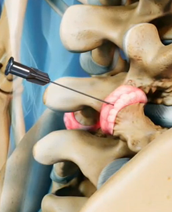Facet Injections / Medial Branch Blocks

A medial branch block is an injection of local anesthetic and cortisone placed outside the joint space near the nerve that supplies the joint called the medial branch. You may require multiple injections depending upon how many joints are involved.
Facet medial branch blocks are typically ordered for patients who have pain primarily in their back coming from arthritic changes in the facet joints or for mechanical low back pain.
A facet block or medial branch block may be therapeutic and/or diagnostic. One of three things may happen.
- The pain does not go away, which means that the pain is probably not coming from the blocked facet joints. This has diagnostic value
- The pain goes away and stays away for a few days to a week but the original pain comes back. This would mean the block was also of diagnostic value and the pain is probably coming from the joints.
- The pain goes away after the block and stays away for a few weeks to a few months. This means that the block was of therapeutic value and the steroid had a long lasting effect on the pain.
If you get good, lasting benefit from the facet injections, the block may be repeated. If you get good, short-term benefit another procedure (radiofrequency lesioning) may be done which may last months to years.
What are the risks of the procedure?
As with most procedures there is a remote risk of bleeding, infection, nerve injury, or allergic reaction to the medications used.
Some short-term side effects may occur. You may have increased pain for a few days after the injection, including localized pain at the injection site. Diabetics may have short-term elevation of blood sugars. People prone to fluid retention may have increased fluid retention for 1-2 weeks.
Will the injection hurt a lot?
Most patients also receive intravenous sedation, which means the procedure is easy to tolerate, but every person’s response can be different.
What happens during the actual procedure?
After signing a consent form and checking your blood pressure the procedure will be done in the fluoroscopy (x-ray) room with you lying on your stomach. For procedures in the neck an intravenous is started. The back is then cleansed with an antiseptic soap. Sterile drapes are placed. Using x-ray guidance, needles are then advanced to the appropriate locations. Once the needles are in the proper location local anesthetic with steroid is injected through the needles and the needles are removed. Your skin will be cleansed and bandages will be applied. (The bandages can be removed on the next morning). Your blood pressure will be checked and you will be discharged to leave with your ride after M.D. authorizes discharge.

